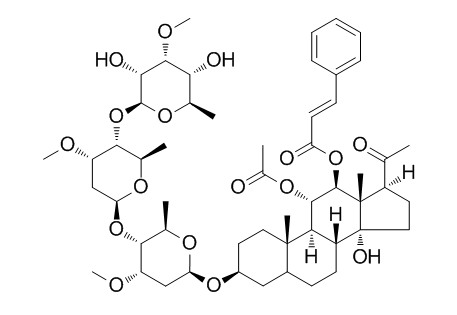Condurango glycoside A
Condurango glycoside A has anticancer activity, it is a potent differentiation inducer, it initiates ROS generation, promoting up-regulation of p53 expression, thus resulting in apoptosis and pre-mature senescence associated with DNA damage.
Inquire / Order:
manager@chemfaces.com
Technical Inquiries:
service@chemfaces.com
Tel:
+86-27-84237783
Fax:
+86-27-84254680
Address:
1 Building, No. 83, CheCheng Rd., Wuhan Economic and Technological Development Zone, Wuhan, Hubei 430056, PRC
Providing storage is as stated on the product vial and the vial is kept tightly sealed, the product can be stored for up to
24 months(2-8C).
Wherever possible, you should prepare and use solutions on the same day. However, if you need to make up stock solutions in advance, we recommend that you store the solution as aliquots in tightly sealed vials at -20C. Generally, these will be useable for up to two weeks. Before use, and prior to opening the vial we recommend that you allow your product to equilibrate to room temperature for at least 1 hour.
Need more advice on solubility, usage and handling? Please email to: service@chemfaces.com
The packaging of the product may have turned upside down during transportation, resulting in the natural compounds adhering to the neck or cap of the vial. take the vial out of its packaging and gently shake to let the compounds fall to the bottom of the vial. for liquid products, centrifuge at 200-500 RPM to gather the liquid at the bottom of the vial. try to avoid loss or contamination during handling.
Horticulture Research2022, uhac276.
Korean J of Food Science&Technology 2017, 49(2):146-150
Legume Science2021, 3(4): e101.
Molecules.2019, 24(2):E343
Oncotarget.2016, 8(51):88386-88400
J Tradit Chin Med.2023, 43(6):1081-1091.
J Mol Recognit.2020, 33(2):e2819
Sci Adv.2018, 4(10)
Int J Mol Sci.2023, 24(24):17589.
J Ethnopharmacol.2024, 320:117426.
Related and Featured Products
Chemical & Pharmaceutical Bulletin, 1994, 42(3):611-616.
Studies on Differentiation Inducers. IV. Pregnane Derivatives from Condurango Cortex.[Reference:
WebLink]
METHODS AND RESULTS:
In connection with the study of differentiation inducers from plants, the methanol extract of Condurango Cortex (bark of Marsdenia condurango REICH, Asclepiadaceae) was investigated to examine its differentiation-inducing activity towards mouse myeloid leukemia (M1) cell line. Six pregnane glycosides, including three new compounds, were isolated as differentiation inducers. Each of the six active glycosides has three or four deoxylated sugars which are well-known to occur in Asclepiadaceae plants. M1 cells were differentiated into phagocytic cells by these glycosides, and they were found to be more effective than their aglycones.
CONCLUSIONS:
Condurango glycoside A (7) and Condurango glycoside C (8), having a cinnamoyl group in their aglycones, were the most potent differentiation inducers and M1 cells became phagocytic cells after 24 h treatment with these compounds.
Molecular and Cellular Biochemistry, 2013, 382(1-2):173-183.
Condurango-glycoside-A fraction of Gonolobus condurango induces DNA damage associated senescence and apoptosis via ROS-dependent p53 signalling pathway in HeLa cells.[Reference:
WebLink]
Gonolobus condurango plant extract is used as an anticancer drug in some traditional systems of medicine including homeopathy, but it apparently lacks any scientific validation. Further, no detailed study is available to suggest whether Condurango glycoside A (CGA), a major ingredient of condurango serves as a potent anticancer compound. Therefore, we investigated apoptosis-inducing ability of CGA against cervix carcinoma cells (HeLa).
METHODS AND RESULTS:
β-galactosidase-activity and DNA damage were critically studied at different time points; while induced DNA-damage was observed at 9–12th hours, senescence of cells appeared at a later stage (18th hour after CGA treatment), implicating thereby a possible role of DNA damage in inducing pre-mature cell senescence. Concurrently, the number of cells undergoing apoptosis increased along with increase in reactive oxygen species (ROS) generation. Expression of p53 was also up-regulated, indicating that apoptosis could have been mediated through p53 pathway. DCHFDA (4′,6-Diamidino-2-phenylindole dihydrochloride) assay, acridine orange/ethidium bromide staining and annexin V/PI assay results collectively confirmed that apoptosis was induced by increased ROS generation. Reduction in proliferation of cells was further evidenced by the cell cycle arrest at G0/G1 stage. Expression profiles of certain relevant genes and proteins like p53, Akt, Bcl-2, Bax, cytochrome c and caspase 3 also provided evidence of ROS mediated p53 up-regulation and further boost in Bax expression and followed by cytochrome c release and activation of caspase 3.
CONCLUSIONS:
Overall results suggest that CGA initiates ROS generation, promoting up-regulation of p53 expression, thus resulting in apoptosis and pre-mature senescence associated with DNA damage.



